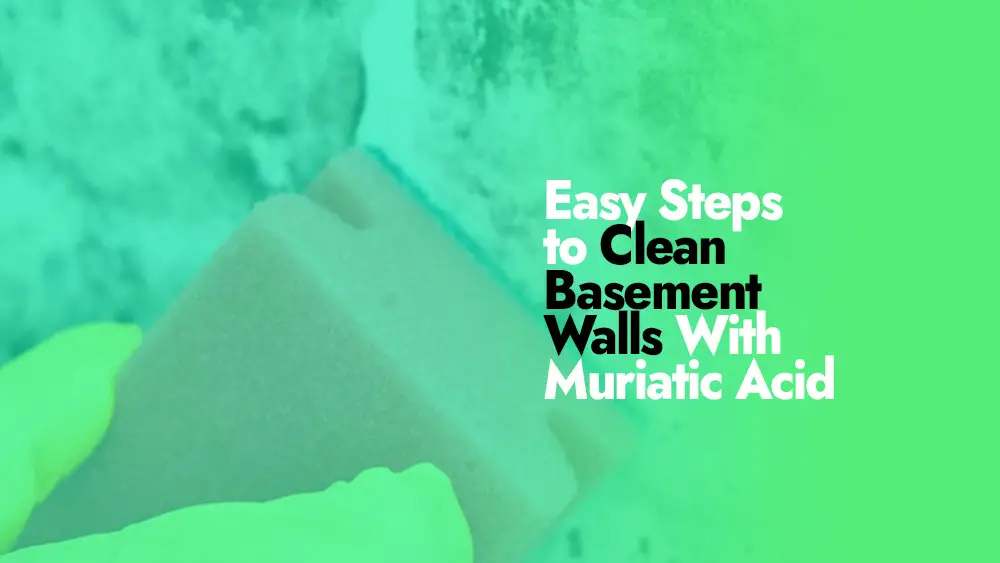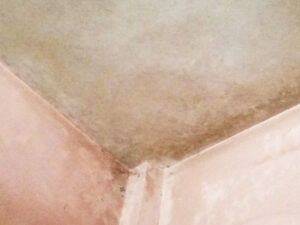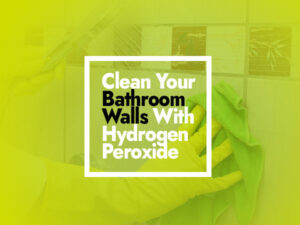Cleaning the walls of a basement can be hard, especially if there are spots, mold, or mildew that won’t come off. Using muriatic acid is a popular way that has been shown to work well. Hydrochloric acid, which is another name for muriatic acid, is a strong chemical that can be used to get rid of tough spots and clean surfaces. But it’s important to be careful when cleaning with muriatic acid because it can be dangerous if not treated correctly. In this guide, we’ll show you step-by-step how to use muriatic acid to clean your basement walls in a safe and effective way. We’ll also talk about the safety steps you need to take, the equipment you’ll need, and other ways to clean. By following these steps, you can clean and freshen up your basement walls without putting yourself in danger.
What is muriatic acid, and why might I use it to clean the walls of my basement?
Hydrochloric acid, which is another name for muriatic acid, is a strong and very acidic acid that is often used to clean and etch different surfaces. It is a mixture of hydrogen chloride gas and water, which makes a strong acid with a low pH. Muriatic acid is easy to find at hardware stores, home improvement stores, and places that sell pool supplies.
Muriatic acid can be a good way to clean the walls of a basement by getting rid of tough stains, mineral deposits, efflorescence, and other tough leftovers. Moisture is a common problem in basements, which can cause mold, mildew, or mineral deposits to grow. Because muriatic acid is acidic, it can break down and remove these things, making it easier to clean the walls.
One of the main reasons people use muriatic acid is that it can get rid of efflorescence. When water evaporates from masonry materials like concrete or brick, it leaves behind a white powdery layer called efflorescence. It happens when salts move to the surface and leave spots that don’t look good. Muriatic acid can get rid of these layers and make the basement walls look new again.
Muriatic acid is also often used to get rid of mineral layers like calcium or lime that can build up on the walls of a basement. Most of the time, these deposits look like white or gray spots that are hard to get rid of with regular cleaning methods. The acidic nature of muriatic acid helps break down and dissolve these mineral layers, making it easier to clean and return the walls to their original state.
But it is important to be careful when using muriatic acid. Because it is corrosive, it can burn you and make dangerous fumes if you don’t handle it right. When using muriatic acid, it is important to follow safety rules, wear the right protective gear (like gloves, shields, and a respirator), and make sure there is enough airflow. Also, you shouldn’t use muriatic acid on things like plywood, wood, or painted walls, because it can damage them.
In conclusion, muriatic acid is a strong and effective cleaner that is used to remove stains, efflorescence, and mineral layers from basement walls. But it should be used with care and the right safety precautions so that you don’t hurt yourself or the things you’re cleaning.
How to Use Muriatic Acid to Clean Basement Walls

To clean basement walls with muriatic acid safely and effectively, you need to plan and do it carefully. Here’s how to clean the walls of a basement with muriatic acid:
Precautions for Safety
When dealing with muriatic acid, it is important to put safety first. Start by putting on the right safety gear, such as gloves that can handle chemicals, safety glasses, a mask to protect against fumes and clothes that cover your arms and legs. Open windows or use ventilation fans to get the air moving and reduce the amount of fumes in the room.
It is also important to have baking soda or ammonia on hand to clean up any spills or drips that might happen while cleaning. Also, keep pets and kids away from the area so they don’t get hurt by the acid by chance.
Water down the Muriatic Acid
To use muriatic acid safely, it must be mixed in the right way. Fill up a big bucket or plastic container with water. Read and carefully follow the instructions from the maker to figure out how much water to add to the acid.
Always remember to add the acid to the water, not the other way around. When you mix things in this order, you avoid dangerous responses and splashing. Make sure the acid is spread out evenly in the water by giving the mixture a gentle stir.
A Small Area to Test
Before putting the weakened acid solution on the whole basement wall, it’s important to test it in a small, hidden spot. Choose a part of the wall that is not easy to see and use a brush or sponge to spread the acid mixture that has been dissolved.
As instructed by the maker, let the solution sit on the wall for a few minutes. Rinse the area well with water after the time has passed. Watch the results to make sure that the answer doesn’t hurt the wall or cause any other bad things to happen.
Clean the walls of the basement
Now that you’ve tried the acid solution on your basement walls and made sure it won’t hurt them, you can start cleaning. Apply the diluted acid mixture to the walls with a brush or sprayer in small areas. Beginning at the top, work your way down. Scrub the walls with a soft brush to get rid of spots, mold, or mildew.
For spots that won’t come out, you might need a stiff brush or a scrubbing pad. Be careful not to scrub too hard, as this could damage the surface of the wall. Let the acid solution sit on the walls for as long as it says to, usually a few minutes, but don’t let it dry.
Clean up and get rid of
After you’re done cleaning the basement walls, you should get rid of any acid that’s left and clean up the area. Mix baking soda or ammonia with water to make a solution. Use a clean brush or sponge to apply this solution to the walls to neutralize any acid that is still there.
Make sure to cover all of the cleaned areas well. Rinse the walls again with clean water to get rid of any leftover acid, and neutralize the solution or residue. Follow the rules in your area for how to get rid of the diluted acid and neutralizing treatments.
Post-Cleaning
Once the walls are dry, check them carefully to make sure that all of the marks and residue have been removed. If you find spots or marks that you missed or that are still there, you may need to repeat the cleaning process just for those areas.
Take the time you need to get your basement walls as clean and nice-looking as you want. Always put safety first and follow the guidelines for using muriatic acid, no matter where you are in the process. If you have questions or worries, talk to professionals or ask experts in the field for help.
Is there anything else that can be used to clean instead of muriatic acid?
Yes, you don’t have to use muriatic acid to clean basement walls. There are other ways to clean them. Different people may choose these options for different reasons, such as safety concerns, the possibility of damaging certain wall materials, or personal taste. Let’s look at some good ways to clean basement walls that don’t involve muriatic acid:
Vinegar
Vinegar is a natural cleaner that can be used for many different things. It can get rid of spots, dirt, and even some types of mold and mildew. Because it is acidic, it can be used to clean many surfaces, including the walls of a basement.
Mix white vinegar and water in a spray bottle until the amounts are the same. Spray the solution on the wall, wait a few minutes, and then use a brush or sponge to gently scrub the surface. After that, wash the walls well with clean water.
Hydrogen Peroxide
Hydrogen peroxide is a gentle cleaner that is safe for the environment and can be used to get rid of stains, kill mold and mildew, and clean up spills. In a spray bottle, mix equal amounts of hydrogen peroxide and water.
Spray the solution on the damaged parts of the basement walls and let it sit for 10 to 15 minutes. Use a brush or sponge to gently scrub the walls to get rid of spots and mold. Run water over the walls to get rid of any leftovers.
Baking Soda
Baking soda is a natural, gentle agent that can be used to clean many things, including the walls of a basement. Make a paste by mixing baking soda and water until the mixture is thick. Use a brush or sponge to gently scrub the walls where there are stains or dirt with the paste. Baking soda can help get rid of smells and spots that are hard to get rid of. Rinse the walls with water to get rid of any leftover dirt.
Oxygen Bleach
Sodium percarbonate, which is also called oxygen bleach, is a non-toxic option to chlorine bleach. It can clean well and get rid of spots without hurting the surface. Follow the directions on the box to mix the powder with water and use it to clean the walls of your basement. Use a brush or sprayer to put the solution on the walls, and then let it sit for the time given. If you need to, gently scrub the walls and then rinse them well with water.
Commercial Cleaners
There are many tools on the market that are made just for cleaning basement walls. Most of the time, these cleaners have enzymes, surfactants, and other active ingredients that can get rid of spots, mold, and mildew. When you use these cleaners, it’s important to read and follow the directions given by the maker. Some industrial cleaners may need to be mixed with water or used in a certain way.
Pressure Washing
If the walls of the basement are made of materials that can handle pressure washing, it can be a good way to get rid of dirt, spots, and other things. High-pressure water is used to clean surfaces with pressure washing, which can be especially helpful for big areas or walls that are very dirty. But it’s important to be careful and use the right pressure settings to keep the walls from getting damaged or water from getting in.
When thinking about other ways to clean your basement walls, it’s important to think about what they need and what they’re made of. Some alternative ways might be better for certain kinds of stains or wall surfaces, while others might not work as well. Before using an alternative cleaning method on the whole wall, it’s best to try it out in a small, hidden area first.
Final Thoughts
Using muriatic acid to clean the walls of a basement can be a good way to get rid of tough spots and grime. But it is important to put safety first at every step of the process. Put on safety clothes, gloves, and goggles, and make sure the area has enough airflow. To prevent damage, mix the acid with water and try it out on a small area first.
Scrub the walls gently with a stiff brush, rinse well, and get rid of the acid in the right way. Remember that muriatic acid is a dangerous chemical that needs to be treated carefully. If you’re not sure how to clean basement walls safely and effectively, it’s best to ask an expert.







